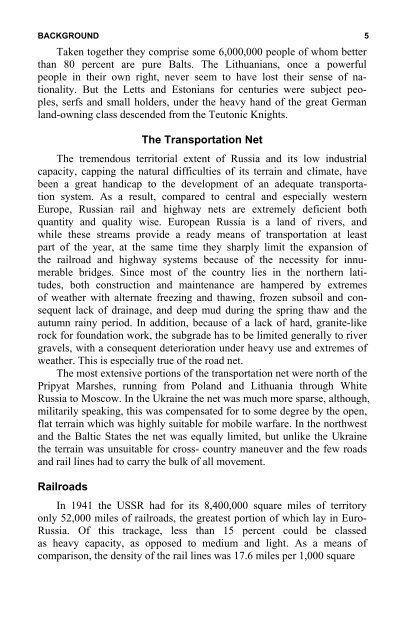the soviet partisan movement 1941-1944 by edgar m. howell
the soviet partisan movement 1941-1944 by edgar m. howell
the soviet partisan movement 1941-1944 by edgar m. howell
You also want an ePaper? Increase the reach of your titles
YUMPU automatically turns print PDFs into web optimized ePapers that Google loves.
BACKGROUND 5<br />
Taken toge<strong>the</strong>r <strong>the</strong>y comprise some 6,000,000 people of whom better<br />
than 80 percent are pure Balts. The Lithuanians, once a powerful<br />
people in <strong>the</strong>ir own right, never seem to have lost <strong>the</strong>ir sense of nationality.<br />
But <strong>the</strong> Letts and Estonians for centuries were subject peoples,<br />
serfs and small holders, under <strong>the</strong> heavy hand of <strong>the</strong> great German<br />
land-owning class descended from <strong>the</strong> Teutonic Knights.<br />
The Transportation Net<br />
The tremendous territorial extent of Russia and its low industrial<br />
capacity, capping <strong>the</strong> natural difficulties of its terrain and climate, have<br />
been a great handicap to <strong>the</strong> development of an adequate transportation<br />
system. As a result, compared to central and especially western<br />
Europe, Russian rail and highway nets are extremely deficient both<br />
quantity and quality wise. European Russia is a land of rivers, and<br />
while <strong>the</strong>se streams provide a ready means of transportation at least<br />
part of <strong>the</strong> year, at <strong>the</strong> same time <strong>the</strong>y sharply limit <strong>the</strong> expansion of<br />
<strong>the</strong> railroad and highway systems because of <strong>the</strong> necessity for innumerable<br />
bridges. Since most of <strong>the</strong> country lies in <strong>the</strong> nor<strong>the</strong>rn latitudes,<br />
both construction and maintenance are hampered <strong>by</strong> extremes<br />
of wea<strong>the</strong>r with alternate freezing and thawing, frozen subsoil and consequent<br />
lack of drainage, and deep mud during <strong>the</strong> spring thaw and <strong>the</strong><br />
autumn rainy period. In addition, because of a lack of hard, granite-like<br />
rock for foundation work, <strong>the</strong> subgrade has to be limited generally to river<br />
gravels, with a consequent deterioration under heavy use and extremes of<br />
wea<strong>the</strong>r. This is especially true of <strong>the</strong> road net.<br />
The most extensive portions of <strong>the</strong> transportation net were north of <strong>the</strong><br />
Pripyat Marshes, running from Poland and Lithuania through White<br />
Russia to Moscow. In <strong>the</strong> Ukraine <strong>the</strong> net was much more sparse, although,<br />
militarily speaking, this was compensated for to some degree <strong>by</strong> <strong>the</strong> open,<br />
flat terrain which was highly suitable for mobile warfare. In <strong>the</strong> northwest<br />
and <strong>the</strong> Baltic States <strong>the</strong> net was equally limited, but unlike <strong>the</strong> Ukraine<br />
<strong>the</strong> terrain was unsuitable for cross- country maneuver and <strong>the</strong> few roads<br />
and rail lines had to carry <strong>the</strong> bulk of all <strong>movement</strong>.<br />
Railroads<br />
In <strong>1941</strong> <strong>the</strong> USSR had for its 8,400,000 square miles of territory<br />
only 52,000 miles of railroads, <strong>the</strong> greatest portion of which lay in Euro-<br />
Russia. Of this trackage, less than 15 percent could be classed<br />
as heavy capacity, as opposed to medium and light. As a means of<br />
comparison, <strong>the</strong> density of <strong>the</strong> rail lines was 17.6 miles per 1,000 square
















